CBD 101 (CBD Basics)
CBD 101

CBD FOR DUMMIES
Thank you for visiting our CBD education page which will give you enough knowledge about CBD and how it works.
CBD is an abbreviation for Cannabidiol which is derived from cannabis plants. Unlike tetrahydrocannabinol (THC), CBD contains all the medicinal aspects of the plant without containing psychoactive properties. In a nutshell, CBD does not get you high or have the side effects associated with marijuana and THC.
CBD or HEMP What's the difference?
The plant Cannabis sativa has two primary species, hemp, and marijuana. Both contain CBD, but there's a much higher CBD percentage in hemp, which also has very low (less than 0.3%) levels of THC compared to marijuana.
So when you hear people talking about or marketing hemp oil, they're referring to oil extracted from the seeds of the hemp plant. The main thing to remember is there are no cannabinoids—CBD or THC—in hemp oil. There are, however, a lot of healthy fats. This is usually used in beauty products for its moisturizing benefits.
Health Benefits of CBD?
While there have not been a lot of scientific studies on CBD and going by what people say is merely anecdotal. It is worth noting to speak with a health care professional to see what's right for you.
What is the Endocannabinoid System?
To understand this system, you have to understand homeostasis. Homeostasis is simply your body's internal environment. When it gets thrown out of balance from pain, inflammation, or any other cause - the effect is that your endocannabinoid system goes into action automatically to try to restore normal operation.
The Endocannabinoid System (ECS) is a cell-signaling system discovered in the 1990s while researching THC and its effects on humans. Medical professionals have identified that all humans have an ECS system, regardless of whether they have ever used a cannabis-related product. The ECS plays a vital role in Sleep, Mood, Appetite, Memory, Reproduction and Fertility. The three major components of your ECS system are Enzymes (These break down the CBD), Endocannabinoid Receptors (These are where your body imports the CBD), and Endocannabinoids (These are molecules manufactured by your body to regulate your functions) also known as "endogenous cannabinoids).

Your body has two types of built-in Endocannabinoid receptors, CB1 receptors in your central nervous system and CB2 receptors in your peripheral nervous system-especially your immunity cells. When you take CBD, endocannabinoids can bind with either receptor and thus initiate a healing and transformative process.
Anxiety and CBD: It gets thrown around a lot
CBD might be worth trying to manage symptoms of anxiety. It does seem to let your body and nervous system calm down. But remember it is not a one-stop-cure-all miracle fix. Again, the best approach is to talk it over with your health care provider.
Tinctures, edibles, vape, oils, lotions and on and on. What's the best way to take CBD? I would ask first, what is your goal for taking CBD?
Are you taking it for relief of joint muscle pain? Maybe you do not want to eat or ingest anything. The biggest differences between tinctures, edibles, and vape pens are the speed of delivery and how long the effects last. Vape relief is faster but wears off faster too, usually in about two hours. Tinctures and edibles take longer to start working, but they tend to last four to five hours.
OK, so I'm ready to try CBD. What do I look for?
Has it been third-party tested? All CBD sold in the USA should be accompanied by a third-party laboratory report that not only verifies all the labeled ingredients but also verifies the milligrams of CBD contained in each product. Most of the cost of CBD products is the CBD content, so this is very important.
Does it claim to cure any disease? If so, I would pass on this and find some other brand. The holistic properties of CBD have been proven over and over again in medical journals and clinical trials, but per the FDA, these products cannot be labeled as such.
Legality of CBD. Always check your local laws as they could and can change. CBD is legal in forty-seven states with the following four exceptions: Iowa, North Dakota, and Nebraska. Many states have restrictions like
- CBD content must be derived from Hemp Plants, not Marijuana plants in most states, but more liberal states like California allow CBD from marijuana-based sources. Since we are based in Dallas, Texas, all of our CBD products are derived from hemp plants.
- Certain states like Idaho require that CBD products contain 0% THC.
- Maine, Michigan, Maryland, New Hampshire, New York, North Carolina, Ohio do not allow edibles or beverages.
- Missouri only allows the sale of CBD products to those who have been diagnosed with epilepsy.

Traveling with CBD: Make sure you keep your CBD products in their original packaging that clearly demonstrates legality and <3% THC content.
Drug tests and CBD: According to www.webmd.com, as long as the products you ingest contain pure CBD, you are not at risk of failing a drug test. The general medical consensus is that this is not a concern unless you are able to take extreme amounts and have had an extremely uncommon and intensive test such as gas chromatography.
CBD and Pets: As all living things have an endocannabinoid system (ECS), CBD will have the exact same effect on pets as it will on humans. One study performed by the National Institute for Health (NIH) sought to assess the safety, anti-inflammatory properties, and anti-pain properties of CBD oil in dogs with osteoarthritis. Researchers gave dogs doses of 2 or 8 milligrams (mg) per kilogram (kg) of body weight. Eighty percent of the dogs showed improvement in their pain and mobility, as measured by two veterinary resources — the canine brief pain inventory and the Hudson activity scale.
CBD Verbiage, Terminology, Nomenclature.
References:
Healthline: A Simple Guide To The Endocannabinoid System
https://www.healthline.com/health/cbd-for-dogs#conditions-and-uses
https://www.theveritasfarms.com/blog/cbd-glossary/
